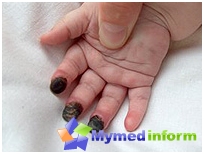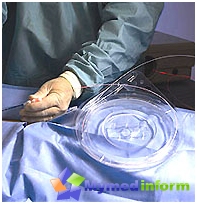What is Gangrene? What it happens? How is the treatment and prevention of gangrenes? Answers you will find in the article.
Content
What is Gangrene
Gangrena is an derocation (necrosis) of any part of the body or body with a characteristic change in its coloring from bluing to drone or black.
Gangrena develops with a termination or sharp limitation of oxygen tissues; It is usually found in places that are most remote from the heart (for example, in the fingers of the limbs), or foci with a local circulatory disorder (for example, in a heartcard or an easy-to-heart attack).
Gangrene can be caused by external and internal causes. External are mechanical (for example, injuries accompanied by crushing, bosmed by tissues with violation of vessels and nerves, breakdown), physical (burns, frostbite), the effect of ionizing radiation, chemical (impact on the body of strong acids and alkalis, arsenic, phosphorus, etc.). Internal reasons belong to states and processes leading to disruption of tissue nutrition, mainly damage to blood vessels - injuries, blockage of arterial stems, narrowing of vessels in spasms or anatomical changes, for example, atherosclerosis, which is often the cause of heart attacks, thrombosis, elder gangrene.
Gangrene can flow without the effects of microbes (aseptic gangrene) and with their participation (septic, or rotary, gangrene). Dry and wet gangrenes distinguish, as well as gas gangrene.
Dry gangrene
 It develops with a rapid cessation of the inflow to blood tissues and their drying, if a rotten infection does not penetrate into the dead tissue. It is characterized by drying, wrinkling and sealing tissues (the affected part decreases in volume), which is associated with the conversion of cell proteins and the decay of uniform elements of blood. Donted plot acquires dark brown or black. According to the external similarity of such a plot with a mummy, the process leading to the formation of dry gangrene is called mummification.
It develops with a rapid cessation of the inflow to blood tissues and their drying, if a rotten infection does not penetrate into the dead tissue. It is characterized by drying, wrinkling and sealing tissues (the affected part decreases in volume), which is associated with the conversion of cell proteins and the decay of uniform elements of blood. Donted plot acquires dark brown or black. According to the external similarity of such a plot with a mummy, the process leading to the formation of dry gangrene is called mummification.
The termination of blood flow is accompanied by a sharp pain in the zone of impaired blood circulation, the limb pale, becomes marble-blue and cold. Pulse and skin sensitivity disappear, although in deep-fat tissues the pain holds long. From the periphery of the death distributed to the center. The function of the affected part of the body is broken. Over time, on the border of dead and healthy tissue, reactive inflammation is developing (demarcation), leading to the rejection of the dead.
Dry gangrene is usually localized on the limbs, the tip of the nose and the abnormal sinks (especially when frostbite and chemical burns). Penetration into dead tissues of a rotary infection can cause the transition of dry gangrene into a wet. After a few months, the dead plot can independently turn away.
With aseptic necrosis of internal organs, there is a gradual resorption of a dead section with a replacement by its scar cloth or the formation of cysts (muscle of the heart, brain). If the reaction of the adjacent tissue with the gangrenous section of healthy tissues is sluggish, the death process applies to them. In this case, the blood decomposition products fall into the blood, which can lead to severe intoxication.
Wet gangrene
It is characterized by a grayish-brown color of the affected area, tissue waste and an increase in their volume. Fabrics are usually converted into a soft mass of dirty-green, emitting a rotten smell; In the future, there is a liquefaction and decay of the tissue.
With a favorable flow on the border between healthy and dead fabrics, a clear boundary is planned. Demanding fabrics are discarded, and the resulting defect heals with the formation of a scar. Sometimes (no infection, limited focus) Wet gangrene can go to dry. If the body is weakened, and the local tissue reaction is sluggish, the process is distributed, the absorption of rotational decay products into general blood flow leads to the development of sepsis (especially often in patients with diabetes sugar). With a wet gangrene, the sensitivity in the surface layers of the affected fabrics is lost, in deeper - pain; body temperature rises; The overall condition of the patient is severe.
Treatment and prevention of gangrene
- elimination of the reasons that can cause the development of gangrene;
- blood transfusion;
- antibiotics;
- surgery









